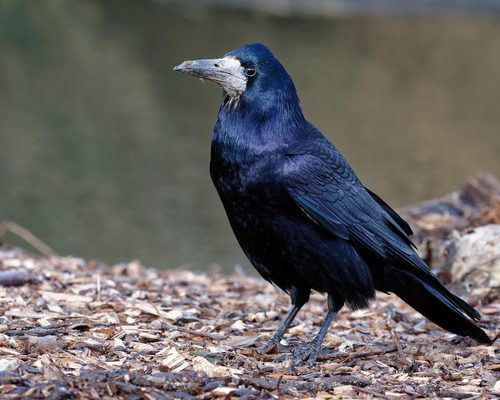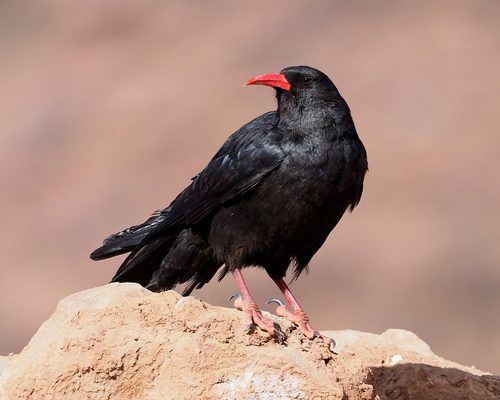Jackdaw
Least ConcernCorvus monedula
Visual Identification
Appearance
The Jackdaw is a small, stocky corvid with a distinctive silvery-grey nape and pale blue-grey eyes. Its body is primarily black, with a glossy sheen on the wings and tail, contrasting with the lighter grey of its neck and underparts.
Juveniles appear duller than adults, lacking the silvery nape and blue-grey eyes. There is no significant difference between male and female plumage, though males are slightly larger on average.
Size
Length
34cm to 39cm
Wingspan
64cm to 73cm
Weight
220g to 270g
Colours
Males and females have similar plumage
Primary Colour
Black Grey
Beak Colour
Black
Leg Colour
Black
Habitat and Distribution
Habitats
Woodland
Garden
Wetland
Coastal
Urban
Farmland
Grassland
Desert
Tundra
Rainforest
Mountain
Savanna
Distribution
Jackdaws are widely distributed across Europe, western Asia, and parts of North Africa. They inhabit a variety of environments, including woodlands, farmlands, coastal cliffs, and urban areas. They show a particular affinity for human settlements, often nesting in chimneys and old buildings.
Jackdaws are resident year-round in the UK and can be found throughout the country. Some northern European populations undertake short-distance migrations to warmer regions during harsh winters.
Elevation Range
Up to 1,600 meters
Climate zones
Temperate, Subarctic
Distribution Map
This map gives you a rough idea of where you might spot a Jackdaw. The coloured areas show countries where these birds have been seen.
A few things to keep in mind:
- Birds might not be everywhere in the coloured areas, for example, they may be present around the coast of that country
- Where birds live can change with seasons and available food
- This map is quite simple - it doesn't show exact locations
We're working on making our maps even better! Soon, we hope to show you:
- More detailed maps for bigger countries, including state and region
- How birds move around during different seasons
Distribution by Region
Behaviour and Ecology
Bird Attributes
This feature is in beta. We'd love your feedback to improve it!
Share your thoughtsBird Attributes Explained
Our bird attributes system rates various aspects of a bird's capabilities on a scale of 0-100, based on data from field observations, scientific studies, and expert knowledge.
Attribute Categories:
- Agility: Manoeuvrability, speed, and grace in flight or movement.
- Strength: Physical power, often correlating with size and hunting abilities.
- Adaptability: Ability to thrive in various environments or changing conditions.
- Aggressiveness: Territorial behaviour and assertiveness, particularly during breeding seasons.
- Endurance: Stamina, often seen in migration patterns or foraging behaviours.
Understanding the Ratings:
- 0-20: Very Low
- 21-40: Low
- 41-60: Average
- 61-80: High
- 81-100: Very High
Remember, these attributes are relative to other bird species and don't necessarily indicate superiority.
Hover over the icon next to each attribute for more information.
Tap the icon next to each attribute for more information.
Agility
Reflects the bird's manoeuvrability, speed, and grace in flight or movement.
Jackdaws display remarkable agility, particularly evident in their acrobatic flight displays during breeding season. Their ability to navigate urban environments, perform aerial manoeuvres, and forage efficiently demonstrates high levels of agility.
Strength
Indicates the bird's physical power, often correlating with size and hunting abilities.
While not exceptionally strong for their size, Jackdaws possess moderate strength. Their ability to probe soil for invertebrates and manipulate objects like nuts indicates decent physical capability, though they're not as powerful as larger corvids.
Adaptability
Represents the bird's ability to thrive in various environments or changing conditions.
Jackdaws exhibit exceptional adaptability. Their success in various habitats, from woodlands to urban areas, and their opportunistic feeding habits showcase their ability to thrive in diverse environments. Their tool use and problem-solving skills further highlight their adaptability.
Aggressiveness
Measures the bird's territorial behaviour and assertiveness, particularly during breeding seasons.
Jackdaws show moderate aggressiveness. While generally social and cooperative within their species, they can be territorial during breeding season and may display aggressive behaviour towards potential predators or when competing for resources.
Endurance
Reflects the bird's stamina, often seen in migration patterns or foraging behaviours.
Jackdaws demonstrate good endurance, evidenced by their ability to undertake short-distance migrations and maintain active foraging behaviours throughout the day. Their success in various climates, from temperate to subarctic, also suggests solid endurance levels.
Diet
Jackdaws are omnivorous and opportunistic feeders. Their diet includes insects and small invertebrates in the summer and seeds and fruits in the winter. They also scavenge human food waste in urban areas and have been known to prey on small birds and mammals.
Jackdaws often forage in fields, using their strong beaks to probe the soil for invertebrates. They are notorious for raiding birds’ nests and even stealing the eggs of large water birds and seabirds.
Behaviour
Jackdaws are highly social birds, often seen in large flocks foraging on the ground or perched on buildings and trees. They are known for their acrobatic flight displays, particularly during the breeding season.
These intelligent birds have been observed using tools and solving complex problems in captivity.
Vocalisation
Jackdaws are vocal birds with a range of calls. Their most common call is a sharp, metallic 'chyak' or 'jack', often repeated in rapid succession.
During courtship and social interactions, they produce softer, chattering sounds. In flight, they may give a higher-pitched 'kya' call, especially when alarmed.
Nesting & Breeding
Jackdaws form monogamous pairs that often mate for life. The breeding season typically begins in April, with courtship displays involving aerial acrobatics and mutual preening.
Nests are built in cavities, including tree holes, cliff crevices, and man-made structures. Both partners participate in nest construction, using sticks, twigs, and softer materials for lining. The female lays 4-5 pale blue or blue-green eggs with brown speckles.
Incubation lasts about 18 days, primarily by the female. Both parents feed the nestlings, which fledge after 28-35 days but continue to depend on their parents for several weeks after leaving the nest.
Lifespan
years
The Jackdaw typically lives for 5 to 10 years.
Like all birds, lifespan can be affected by factors including predation, habitat quality, disease, and access to food sources.
Conservation and Status
Global Conservation Status
While Jackdaws are currently listed as Least Concern due to their large range and stable population, they face localised threats from habitat loss and persecution.
In some areas, efforts are being made to protect nesting sites in old buildings and provide artificial nest boxes to support urban populations.
Birdwatching Tips
- Look for Jackdaws in urban areas, particularly around old buildings and church towers
- Listen for their distinctive 'chyak-chyak' call, which is often heard before the birds are seen
- Observe their social behaviour in flocks, especially during morning and evening roosting times
- In the UK, watch for them in parks and gardens, where they often visit bird feeders
Additional Information
Quick Facts
Other names:
Eurasian Jackdaw, Western Jackdaw
Family:
CorvidaePredators
Main predators of Jackdaws include larger raptors such as Peregrine Falcons, Goshawks, and Eagle Owls. Ground predators like foxes and cats may prey on juveniles or nest contents.
Did You Know?
- Jackdaws can recognise individual human faces and remember whether a person has been threatening or friendly.
- They are one of the few non-mammal species known to engage in eye contact with humans as a form of communication.
- Jackdaws have been observed using cars as 'nutcrackers', dropping nuts on roads for vehicles to crack open.
Was this bird profile helpful?
Your feedback helps us improve our content
Thanks for your feedback!
Your input helps us improve our content.
Community Experience
Community Ratings
No ratings yet - be the first to rate this bird!
Latest Community Reviews
No reviews yet
Sign in to be the first to review
Community Reviews
Create Your Free Account Welcome Back!
Join our community to rate birds and share your experiences. Creating an account is completely free and only takes a minute. Sign in to your account to rate birds and share your experiences with our community.
Your information is secure and will never be shared.
By creating an account, you agree to our Privacy Policy.
FAQs
What's the difference between a Jackdaw and a crow?
Jackdaws are a small species of crow from the Corvus genus. They differ most obviously from the UK’s Carrion Crow and Hooded Crow in size, being just half the weight of these related birds.
Do Jackdaws deter other birds?
Jackdaws occasionally deter or outcompete smaller birds at the bird table. However, it’s important to remember that they are also a natural part of the United Kingdom’s ecosystem and bird fauna. Feeding the Jackdaws on the ground while providing food in a squirrel-proof feeder may help reduce competition between garden birds.
What does it mean to see a Jackdaw?
Jackdaws symbolise different things to different people. For some, spotting a Jackdaw could signify bad luck or even death, while others see them as a good omen. Their faithfulness to their partner has also inspired the belief that they indicate a successful relationship or marriage.
Why are Jackdaws so noisy?
Jackdaws are social birds that use calls to communicate among themselves. They can be especially noisy around their roost, especially just before returning or before heading out for the day. Research indicates that these birds decide when to leave by the volume and urgency of the flock’s calls, so it tends to rise to a crescendo just before they depart.
Similar Birds
References
- 1 2
website: BirdLife International. 2018. Corvus monedula. The IUCN Red List of Threatened Species 2018: e.T22705929A131943991.
View source - 3
report, 2015: EBCC


